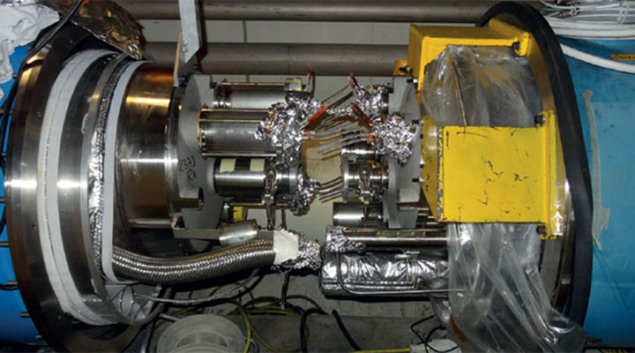

Image credit: S Le Naour.
Following a record year of proton–proton operations at the LHC in 2016, which was followed by a successful proton–lead run, on 5 December 2016 the machine entered a longer than usual winter shutdown. Since then, hundreds of people from CERN’s technical teams have been working to repair and upgrade equipment across the whole accelerator chain and also the LHC experiments themselves. The extended year-end technical stop (EYETS), which will be complete by the end of April, has enabled CERN and its users to perform important interventions including the upgrade of the CMS pixel detector.
As the EYETS officially got under way in early December, 10 days were dedicated to powering tests for the LHC magnets to investigate the feasibility of operating at its design energy of 7 TeV per beam. Although this is only 0.5 TeV higher than the energy of the LHC during Run 2, which began in 2015, the LHC’s 1232 dipole magnets must be trained at higher currents to allow the higher-energy beams to circulate. Powering tests were conducted in two of the LHC’s eight sectors during which the current was gradually increased: in sector 4–5, for example, the current reached 11.535 kA, corresponding to a beam energy of 6.82 TeV. The considerable amount of data collected during the powering tests will now be analysed to define the best strategy for reaching the LHCʼs full design energy.
The EYETS is now in full swing, with several activities taking place: maintenance of cryogenic, ventilation, vacuum, electrical and other systems; upgrades to the accelerators and injectors for the High-Luminosity LHC (HL-LHC) and LHC Injector Upgrade (LIU) projects; consolidation works; and other activities such as the replacement of two lifts that have been in use since the early days of LEP.
The entire LHC has been emptied of liquid helium, which normally keeps the superconducting dipoles at a temperature of 1.9 K, and the bulk of the machine is being held at a temperature of 20 K during the shutdown. This is to avoid wasting any of the precious gas due to unexpected electrical failures during EYETS activities, and also to allow important maintenance works to be carried out on the cryogenic system. Since it takes several weeks to refill, pump and “boil off” the cryogenics before the LHC can restart operations, the already busy EYETS schedule is extremely tight. Cryo-filling of the first sector is foreseen between the end of February and the beginning of March, with the final cool-down expected in early April.
Another major activity is the replacement of a dipole magnet in sector 1–2, which lies between ATLAS and ALICE. This meant that the sector had to be warmed up to ambient conditions, allowing several tests of its electrical quality and liquid-helium insulation at ambient temperature, which revealed no major issues. One of the major risks of warming up a sector is the deformation of the expansion bellows – the thin corrugated structures that compensate for the contraction and expansion of the quench recovery line for the helium distribution system as the machine is cooled and warmed – but X-ray scans performed on all 250 bellows in this sector show no such problems. In addition, the “ball test”, during which a ping-pong ball is fired along the LHC beam-pipe, has been carried out and no faults were found in the sector interconnects.
Regarding the injectors, which transport protons between the various accelerators in the LHC complex, the main EYETS activities concern the Proton Synchrotron Booster (PSB) and the Super Proton Synchrotron (SPS). Critical activities at the PSB include a major de-cabling and cabling campaign, which involves removing all obsolete cables identified during the previous technical stop to make way for the LIU project. Many works are also being carried out on the surface of the PSB to install all the required LIU components.
The SPS is also undergoing a de-cabling and cabling campaign. Other key activities here concern the installation of the cryogenic modules and related infrastructure for the HL-LHC’s superconducting crab cavities (see “On the trail of the HL-LHC magnets”), in addition to civil engineering works to prepare for the replacement of the SPS internal beam dump. The poor functioning of this dump last year limited the number of proton bunches that could be injected from the SPS to the LHC, and the new beam dump will be installed during Long Shutdown 2 beginning the end of 2018.
Despite the extensive works taking place and many technical challenges faced, the EYETS schedule is on track with no major disruptions. Once complete, the LHC will be prepared for its 2017 run, for which commissioning will begin in May.








